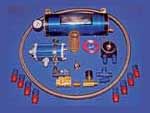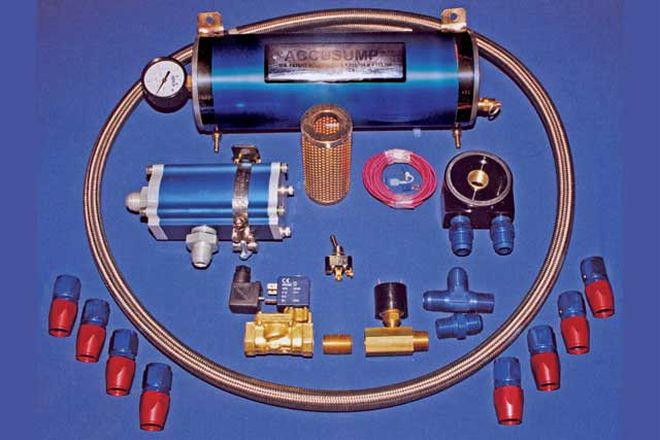
 The basic Electronic Pressure Control (EPC) Accusump and remote oil-filter kit includes a 2-quart Accusump; EPC-valve components; a CM remote filter; -10 AN fittings; AN/NPT adapters; braided hose; and a 90-degree, rotating, remote filter adapter.
The basic Electronic Pressure Control (EPC) Accusump and remote oil-filter kit includes a 2-quart Accusump; EPC-valve components; a CM remote filter; -10 AN fittings; AN/NPT adapters; braided hose; and a 90-degree, rotating, remote filter adapter.
Let's face it, at one point or another we've all worried about the best way to keep our PMD powerplant alive and in good condition for as long as possible. After all, it's not like you can just run over to your local Pontiac dealership nowadays and order up a bare replacement block. Yes, there are still plenty to be found in the salvage market, unless you're like the author and possess something like an early or late SD-, Ram Air-, or H.O.-equipped ride. In that instance, or even with a more bread-and-butter Pontiac engine, you worry about wear and tear on the internals every time you turn the key!
The majority of vintage Pontiac owners drive their rides infrequently, allowing the oil coating on the cylinder walls to slowly work back into the oil pan. Typically, it takes several crankshaft rotations to pressurize the oil galleries at start-up, and until then, the engine has minimal, if any, oil film protecting the surfaces. Independent studies attribute as much as 90 percent of engine wear to cold-start scuffing.
This is why Canton's Accusump system is a desirable modification. While a $500-$600 expenditure that doesn't improve performance may seem a little steep, consider the cost of either replacing or rebuilding a Pontiac engine because of normal wear. Combined with the peace of mind a pre-oiler and surge-protection system provides, it's a more-than-worthwhile expense.
A pre-oiler is nothing new to the internal-combustion engine industry. Patents for such devices date back to the '30s. However, those early units were complex affairs with springs, valves, chambers, and pumps. They never caught on within the automotive industry, most likely due to their expense, reliability, and component-longevity issues.
Canton's Accusump began life as John W. "Jack" Evans' engine pre-oiler and lubricant reservoir (1970, Patent No. 4,094,293) and was developed and sold through his company, Meca Development. Evans later focused his talents on the familiar aftermarket cooling systems that bear his name, and in 1983, Canton Racing Products bought the rights to Evans' pre-oiler.
In the ensuing years, Canton has changed various aspects of the Accusump, refining the internal valving and beefing up the reservoir construction with billet, machined screw-in end caps. Billed as the original oil accumulator, the internal surface of the Accusump's heavy-wall aluminum tube is roller burnished and Teflon hard-coated with a sliding double-O-ring piston that separates the tube into air and oil chambers.
The Accusump pre-oils the engine before you ever turn the key, ensuring that everything is oiled and minimizing friction between contact surfaces. Additionally, when equipped with an electric pressure switch of predetermined range, the Accusump automatically triggers the electric valve to deliver oil to the engine while it's running if a component of the system fails (the pump, pump driveshaft, oil filter, and so on) or the oil pickup is uncovered during braking, cornering, or acceleration. It gives the driver enough time to shut down the engine before more serious damage occurs or the system provides oil to the engine until reaching normal pressure. Accusump systems that use only the electric valve for simple pre-oiling or a manual valve that requires the operator to activate the system for pre-oiling or surge protection are also available.
Due to the tight confines around the oil filter, we used a remote oil filter in this particular Second-Gen Formula application. Over the years, we've seen plenty of remote oil-filter mounting systems in street and race cars. We've also seen quite a few failures of such systems, whether from poor oil delivery and the ensuing internal engine carnage it causes or outright failure of the lines on the track. Most of the former is due to the systems being cobbled together using hardware-store NPT pipe fittings with non-radiused angle fittings, while the latter often stem from poor layout and inferior materials. For example, using hose clamps, straight nipple fittings, kinked hoses, hoses not long enough to compensate for engine movement, and so on.
When assembling the system in our Formula, the number of 90-degree fittings and position of the filter were initially cause for concern. However, after reviewing the proposed system, Canton's tech department assured us there was nothing to worry about as long as we used the proper components. Radiused fittings like those provided by Canton minimize pressure loss whether 45-, 90-, or even 180-degree. If you go the cheap route and build such a system using off-the-shelf plumbing hardware, you're asking for internal damage caused by oil starvation due to pressure losses at the restrictive 90-degree NPT fittings.
Once the installation of the system in the Pontiac was complete, the gauges and line fittings into the Accusump and oil system were leak-tested. There are two methods to do this: First is pressurizing the system with 60 psi of air through the Schrader air valve and applying soapy water to the gauge and hose fittings; any bubbling indicates a leak. The second method is to pressurize the unit, note the pressure indicated on the gauge, and let it sit for up to 24 hours; any loss in pressure indicates a leak.
Once the oiling system was proven to hold pressure, the Accusump was precharged. Pressure was bled off at the Schrader valve to 7-10 psi. The engine was started and the Accusump was activated with the toggle switch, filling the unit. The pressure on the Accusump gauge should be a close match to the engine's oil pressure. After setting the precharge, the oil level in the engine was topped off to account for the oil now held in the Accusump.
One thing to note about the pre-oiling process, since the stock Pontiac oil-pressure sending unit is located at the tail-end of the engine's oiling system, you will only see a little movement on your in-dash gauge. This is normal since the engine's oil pump is not providing any pressure, and oil drainback within the large air volume of the engine block, combined with the open nature of the block thanks to the PCV and breather, won't allow it to continually maintain the pressure level of a running engine.
When ready, the Accusump was switched off, then the engine. Then with the key in the off position or out of the ignition altogether, the Accusump was switched back on.
Now all that's left to do before each start-up is to turn on the ignition. This activates the Accusump since the switch is already in the on position. Wait for it to pre-oil the engine (15 to 30 seconds, depending on the size of the Accusump), and fire up the Poncho mill worry free! You may even notice it cranks easier and starts a couple of revolutions earlier than it used to thanks to the film of oil on the moving parts. Refer to the photos and captions for installation of the system.
Parts And PricesQty.DescriptionPart No.Price (each)12-quart Accusump24-026$185.001Pair 2- or 3-quart mounting clamps24-200$17.501Pair billet 2/3-quart mounting clamps24-210$80.006 feet-10AN braided hose23-605$8.501Electric pressure valve 20-25 psi24-271$148.5011-inch check valve24-280$17.5031/2-inch NPT to -10AN adapter23-245A$5.505-10AN 90-degree fitting23-665$21.753-10AN straight fitting23-625$9.7511/2-inch NPT/2 -10AN T fitting23-245TA$25.501-12AN Port to -10AN fitting23-465A$23.501CM remote filter25-106$80.00190-degree remote-filter adapter22-593$70.001Pontiac Road Race pan15-450$300.001oil-pump pickup15-451$37.50
Complete Cantonization
A Canton 6-quart Road Race oil pan has always been on the wish list for the Formula. In 1973, PMD added a baffle to the stock oil pan and eliminated the windage tray, at least on the Super Duty engines. While adequate for most spirited on-the-road driving, we decided the Formula may eventually see some autocross and hill-climb duty, so a pan upgrade is a worthwhile expenditure.
For Pontiacs, Canton offers four pans. The one shown here has a 7-inch-deep, 10 1/2-inch-long sump that fits all Pontiacs except the GTO. In some instances, stock exhaust systems may interfere with this pan. For GTOs and '67-'69 Firebirds, a pan with an 8-inch-deep, 8-inch-long sump is available. Canton also has a high-capacity 6.5-quart pan with side pouches and a stock replacement pan.